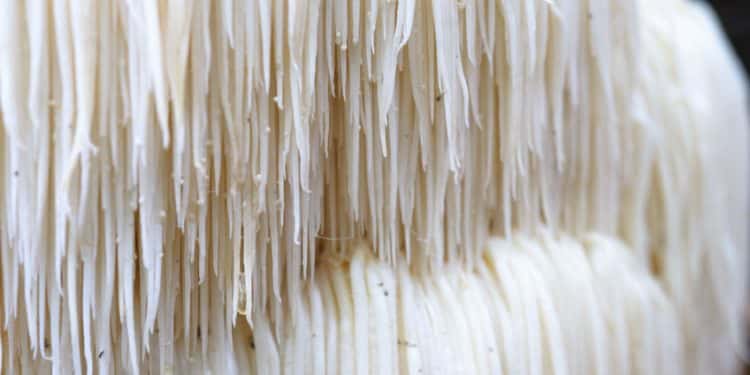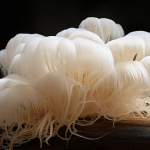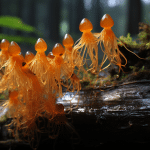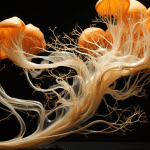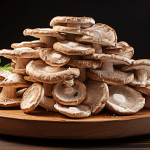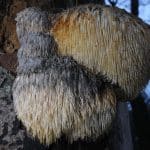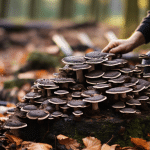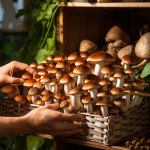It is difficult for me to choose the mushrooms I like best for growing. Aren’t all of them just as awesome? But if I had to pick, I would say that growing lion’s mane mushrooms takes the number one spot. That is because lion’s mane is not only simple and fun to grow, it produces enormous, delicious fruiting bodies that can make for a great addition to any dish. As an added bonus, it boasts some pretty amazing health benefits, too.
Here’s a quick video walking through the process of how to grow lion’s mane:
Unfortunately, you are unlikely to find lion’s mane in your local grocery store so having an affordable source means that you are going to need to figure out how to grow it indoors on your own. Fortunately, this website has plenty of techniques to get you started, but first, let us look at what makes this mushroom so special.
Lion’s Mane Description
Lion’s mane mushrooms grow in big, snowball-like shapes. The mushrooms are white, occasionally turning brown when spines are damaged or as they grow older. Individual mushrooms can grow fairly large, sometimes weighting more than 1lb. The spines, or “teeth”, are fairly small at first, but grow longer as they grow older. The mushrooms are spongey, sometimes half-hollow.
It is sensitive to direct spraying while growing, bruising easily. Lion’s mane mushrooms begin with a small, spiny root.
Natural habitat: Lion’s mane is most often found on hardwood dead and rotting logs, more commonly during fall across North America.
Difficulty of Growing: Easy-Medium
Agar: The lion’s mane is a one-of-a-kind feature in Agar. It seldom grows to the edges of the container, instead creating small, glacial-like formations that radiate outwards from an initial wedge. Long teeth extend from the wedge in every direction.
Mycelium is slow to get going too, at first.
Types of Spawn: Grains, particularly rye grains. Watch the lion’s mane wheat spawns very carefully, because it has the tendency to begin producing well before it is fully settled. Lion’s mane grain spawns must be agitated frequently in order to allow for complete colonization of a spawn.
The mycelium may appear to be thin and flaky, so careful examination is required. It may sometimes appear as though the colonization is incomplete, although it is completely settled.
Soil Type: Lion’s mane grows well on supplementary hardwood sawdust.
Supplement wheat bran to 10% to 20%. Higher fertility rates are effective for lion’s mane, increasing chances of complete colonization. Lion’s mane also grows very well in the “master blend”.
Fruiting container: Use a large filter-patch autoclave growing bag to make fruiting blocks. Once complete colonization is achieved, fruits are produced by cutting tiny “Xs” into the bags either where the fruiting body is located, or wherever the lion’s mane will naturally begin fruiting.
Do not snip the tops off of the bags. More holes will produce more smaller fruits, while less holes will produce less, but larger fruits.
Yield: Over several harvests, you may be able to pick over 2 pounds of lion’s mane from a single 5-pound fruiting block. Some single fruits may be weighed much more than a pound.
Harvest: Harvest lion’s mane by cutting off “snowballs” near your purse with a sharp knife. Be extra gentle with the fruit so you do not hurt the spine. Mushrooms will keep in the fridge for a lot longer when handled gently. Just leave the block of fruiting mushrooms in your growing room, not cutting any new holes in your bags. Subsequent flushes will take place, and the fruit develops in the location where previous fruit was.
Weaknesses: Lion’s mane is occasionally hard to get fully established. Some growers are having greater success using liquid culture techniques. mycelium is slower to grow on agar, and it seldom grows out naturally into a round shape.
The mushrooms are prone to bruises, and extra care should be taken when sprinkling your growing space, and especially when harvesting. Lion’s mane will keep for long periods of time in a refrigerator when handled correctly.
Cooking: Lions mane is a cooking delight, exceedingly versatile in the kitchen.
It acts as a great meat substitute in many dishes, particularly with chicken. It has a rubbery texture and absorbs any flavors that you cook in it. Simply slice mushrooms lengthwise and sauté them in a skillet.
Many find lion’s mane mushrooms a great lobster mimic, roasting them in a skillet with some melted butter. Lions mane mushrooms are also said to have medicinal properties, believed to boost cognitive abilities, initiating neural growth and regeneration. It can be found at health stores.
Some Specifics
Incubate at room temperature for 10-14 days. Watch carefully for wispy, spindly colonies, as well as the first fruiting body to form. The pinching often begins all by itself.
Keep temperatures down to 15 degrees Celsius. Cut holes in a growing bag and put it into a growing room. Temperature to between 15-20 degC. Humidity at 90%. Ensure that you do not spray the fruits directly while spraying. Requirement for fresh air is relatively low.
How to Grow Lion’s Mane Mushroom
The lion’s mane cultivation process is pretty much like growing any other kind of food mushroom, though there are some minor differences that you will want to keep an eye on when learning how to grow lion’s mane mushrooms. Depending on where you are at on the mushroom-growing journey, you will want to take the appropriate approach for growing it at home.
By far, the easiest way to grow lion’s mane at home is by starting out with a set. This is the best option for those who are new to the hobby. Looking for a more authentic lion’s mane experience to make yourself at home?
If so, you can start with a commercially made spawn. This requires some extra tools and some extra experience, but you would have a significantly better outcome. Even better, if you really want to go the whole hog, you can even create your very own starters starting with pure agar cultures.
Lion’s Mane Mushroom Grow Kit
Mushroom growing kits are an excellent choice for people new to the hobby, or do not want to dive into the weeds too deeply. They are essentially just fully-grown blocks of mushrooms.
If you have the set, a lot of the heavy lifting is done for you. You can purchase these kits at a variety of places online, and maybe even your local farmers market. I have even seen kits in the grocery store, though never with the lions mane.
Once you get a unit, all you need to do is place it in a relatively wet environment, and cut a few “x’s” on the sides of your bag. Place the block side down on the plate, and let the mushrooms grow on the top. For moisture, lay a perforated piece of plastic on the block, making sure that there is plenty of empty space between the block and the plastic.
Lion’s mane fruits will begin to form naturally through the holes in the bag. Mist the interior of the bag a couple times per day using a spray bottle, making sure you are ventilating it well to get plenty of fresh air. To make it even better, make yourself a little shotgun-style fruit crate.
You will probably achieve 2 or 3 flies from the kit, and depending on where you live, it may not need any special circumstances at all. Lion’s mane will grow quite nicely in even sub-par conditions, so you should not worry too much about your blocks environment if you are not looking for spectacular results. I even had lion’s mane fruit heavily blocked once after I put it in my garage (with about 65 percent RH) and just forgot about it. The fruits themselves are big, have tiny spines, and will survive for more than a week in the refrigerator, looking no worse for the wear.
Talk about a no-care grow!
Growing from the Spawn
Of course, if you are experienced in growing mushrooms, you can even simply obtain a few lion’s mane spawns and place them in suitable substrates. Hardwood wood chips amended with grits are among the best substrates to grow lion’s mane in.
The usual fruit block formula works well, and it should provide a nice harvest for many re-waterings. I also had a lot of success growing lion’s mane recently in Masters Mix, which is 50-50 hardwood wood chips and soybean shells hydrated up to 60%. Yields appear a bit higher, and the shelf life seems to be slightly better on this substrate, though a bit more experimenting is needed.
Lion’s mane may be grown on straw as well, though I have not personally tried that method. Growing lion’s mane on straw may yield good results only with specific strains specifically tailored to grow on straw. For best results, you are better off simply using a wood-based substrate.
Add the spawn at 10-15% of spawn rates for sterilized substrates in clean environments.
A laminar flow hood works best. Although lion’s mane is fairly immune to contaminants, you still need to use every precautionary measure possible to keep your growing environment safe. Once contaminated, the fruit unit should fully inoculate in 2 weeks. Lion’s mane mycelium may appear flaky and delicate where it is present, looking very different from more solidly formed things such as oysters or reishi.
Do not get alarmed if a patch does not appear to have been completely colonized. This mushroom is very easy to produce a fruit from, so chances are that before you put it out under the conditions of a fruiting environment, you’ll begin to see little fruits form inside of the block. When that happens, just take the bag out into the area of fruiting and cut off little “Xs” where fruit is already formed. The Xs will keep developing, eventually producing larger mushrooms out of the packet.
Growing Lion’s Mane From Scratch
If you are looking to start growing lion’s mane from scratch, it is best to start off by starting the culture in agar, then making the spawn yourself with grains from that. You can also start with a liquid culture, though you are still better off simply placing your liquid culture on agar to store it for the long haul and reuse it. The process is similar to the lion’s mane in other species: brew a culture on agar, produce granular cultures, add to the mass media, and harvest. As long as you have a healthy culture, you should be able to grow fresh lion’s mane whenever you like.
Lion’s mane mycelium lasts for an extended period of time on the culture dish. In fact, I have cultures over 3 years old still performing great.
If you are looking to keep plates long-term, make sure to store them in a refrigerator. Lion’s mane mycelium is prone to spawning on the agar plates, creating long stalks which will ultimately attempt to push themselves off of the plate, leading to contamination. Keeping your cultures in a refrigerator will keep that from happening.
Additional Resources:
How to dry lion’s mane mushroom
How to store lion’s mane mushrooms
You can find our favorite capsules, powders, and tincture’s on the following pages of our website and learn more about each individually:
The Best Lion’s Mane Supplement
Updated 10/10/2022
